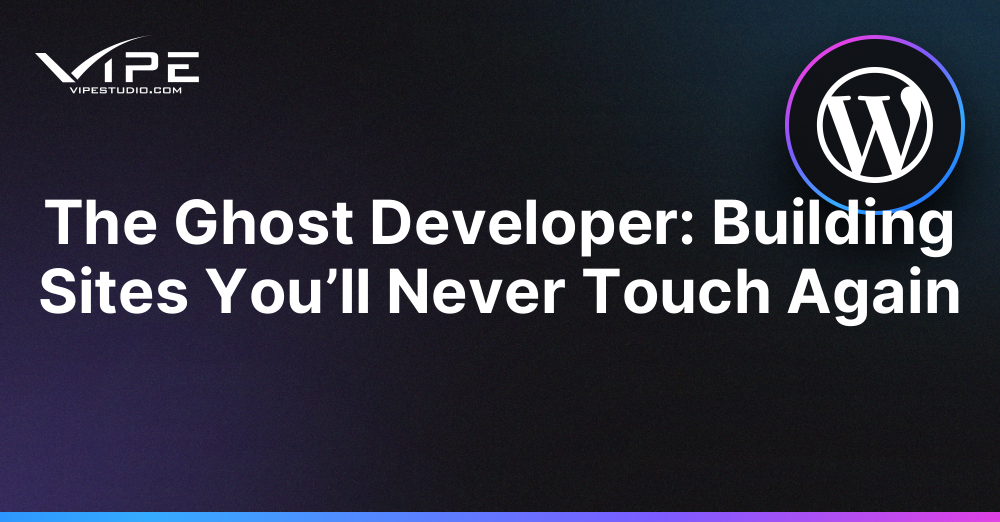30.10.2025
WordPress Development
The Ghost Developer: Building Sites You’ll Never Touch Again
READING TIME: MIN
Table of Content
Introduction: The Ephemeral Nature of Modern Web Work
Most developers dream of building projects that last, but the reality of modern web work often paints a different picture. Many WordPress professionals find themselves acting like “ghost developers”-building sites that, once launched, are never touched again. These projects go live, serve their immediate purpose, and then fade into neglect. They become digital ghosts: still online, but untouched, unmaintained, and ultimately forgotten. This raises an important question about sustainability, responsibility, and the long-term role of developers in a disposable digital economy.
What Does It Mean to Be a Ghost Developer?
A ghost developer is not defined by skill or intent, but by circumstance. You build a site, deliver it, and then walk away-whether by client choice, budget limitations, or a lack of long-term planning. The site may run for months or even years, but without updates, backups, or revisions, it’s destined to break down. The irony is that these ghost sites often appear polished at launch, yet beneath the surface, they’re fragile. This cycle creates a hidden graveyard of abandoned projects across the web, many of them powered by WordPress.
Why Ghost Development Happens
There are several reasons why so many WordPress sites fall into ghost territory:
- Budget constraints: Clients may only want a launch, not ongoing support.
- Lack of awareness: Non-technical users underestimate the need for updates and maintenance.
- Short-term goals: Sites are built to support a campaign, event, or temporary purpose.
- Developer burnout: Freelancers may juggle too many clients, limiting follow-up capacity.
In many cases, the problem isn’t negligence but a misalignment between the value of long-term stewardship and the immediate demand for quick deliverables. For some, this means seeking structured support- sometimes by partnering with a WordPress development team-to avoid future ghost projects.
The Hidden Cost of Abandoned Sites
Ghost sites may appear harmless, but they carry significant risks and hidden costs. Outdated plugins and themes create security vulnerabilities. Neglected backups make recovery impossible after a crash. Search rankings decline as performance lags. Ultimately, businesses lose credibility when their site breaks or becomes outdated. What was once an asset becomes a liability. The cost of fixing an abandoned site is often higher than maintaining it properly from the start.
The Developer’s Dilemma: Responsibility vs. Reality
Should developers feel responsible for what happens after handoff? This is the ethical dilemma at the heart of ghost development. On one hand, professionals want their work to endure. On the other, clients often resist investing in ongoing support. Developers are left in a gray area, uncertain whether to insist on maintenance agreements or accept that some sites will inevitably be abandoned. This tension highlights the need for clearer communication about what it really takes to keep a WordPress site alive.
Building for Longevity Even Without Guarantees
Even if developers know a site may not receive ongoing support, there are ways to build resilience into the project:
- Use stable, well-supported plugins and themes.
- Enable automatic updates for WordPress core, themes, and plugins.
- Integrate simple backup solutions that clients can manage easily.
- Document everything to reduce the burden on whoever inherits the site.
These strategies won’t prevent abandonment, but they at least slow the decay. In many cases, ghost developers unknowingly lay the groundwork for future revival, where another professional- or even the same client years later- picks up the site and breathes new life into it.
When Ghost Sites Come Back to Life
Interestingly, some ghost projects don’t remain abandoned forever. Businesses may rediscover the need for an old site, or clients may finally realize the risks of neglect. At this point, the developer who built the site may no longer be around, leaving someone else to repair or rebuild. This resurrection process is often more costly and complicated than if the site had been maintained from the start. It also raises another question: should developers design their work with future unknown maintainers in mind?
Preventing the Cycle of Ghost Development
Breaking the ghost cycle requires cultural change in how developers and clients approach websites. Instead of viewing a website as a one-off product, it must be seen as an evolving system that needs ongoing care. Clear contracts, education for clients, and built-in maintenance options can prevent ghosting from happening in the first place. Some agencies adopt retainer models to ensure continued engagement, while freelancers may encourage annual check-ins to keep sites alive. For complex builds, this sometimes means involving specialists in long-term WordPress maintenance-who can take over stewardship when developers move on.
The Bigger Picture: Sustainability in Web Development
The ghost developer phenomenon is part of a larger issue: the unsustainable churn of the web. Websites are launched, neglected, and abandoned at a staggering pace, contributing to what some call “digital waste.” If developers, agencies, and clients adopted more sustainable practices, fewer ghost sites would haunt the internet. The long-term health of the web depends on rethinking responsibility-not just in terms of features and launch dates, but in terms of durability and legacy.
Conclusion: Accepting the Ghost in the Machine
Not every site will survive. Some will fade by design, while others will collapse through neglect. But ghost development doesn’t have to be the norm. By building with care, educating clients, and encouraging sustainable practices, developers can reduce the number of abandoned sites haunting the digital landscape. WordPress, with its flexibility and vast ecosystem, provides the tools for longevity-but without stewardship, even the best-built site risks becoming a ghost. The challenge is not just technical but cultural: shifting from a disposable mindset to one of responsibility and resilience.
Key takeaways
- Ghost development happens when sites are launched but never maintained.
- Budget, awareness, and short-term goals fuel the cycle of abandonment.
- Abandoned sites create security, performance, and credibility risks.
- Developers can mitigate risks by building resilient, well-documented sites.
- Resurrection of ghost sites is costly compared to continuous maintenance.
- Sustainable practices and cultural shifts can reduce digital neglect.
More on The Topic
- WordPress Performance Debt Nobody Talks About
- The Admin UX That Shapes Decisions
- Scaling WordPress Without Losing Culture
- WordPress 6.9 “Gene”: What This Release Really Changes
- Managing Gutenberg Chaos at Scale
The content of this website is copyrighted and protected by Creative Commons 4.0.



